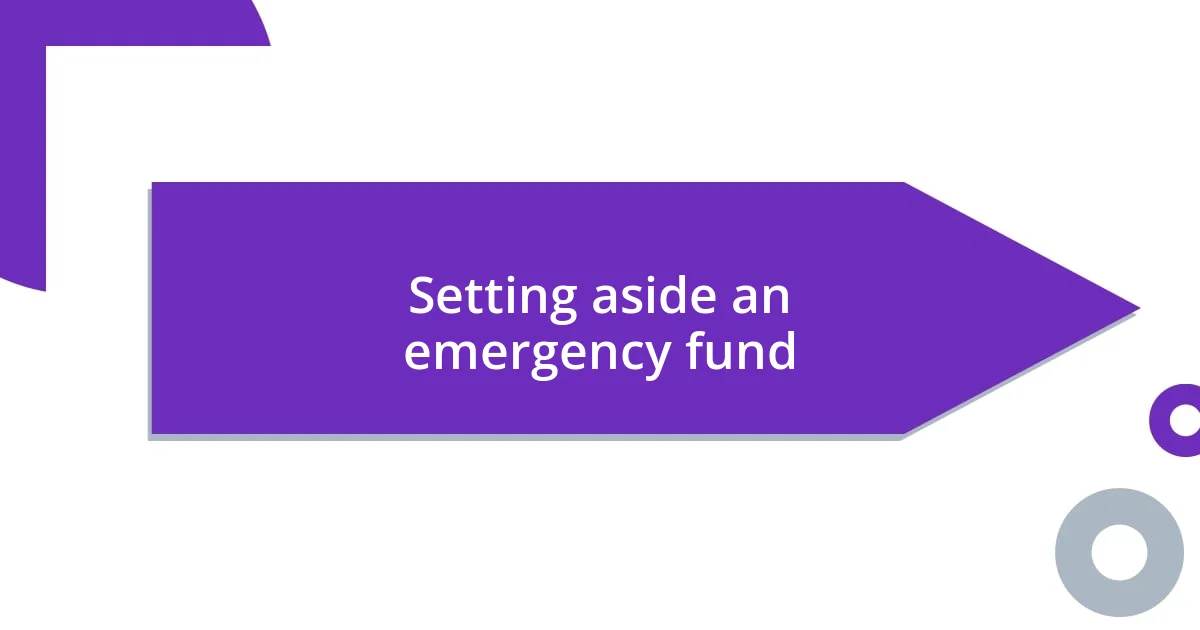Key takeaways:
- Developing a flexible budget and setting aside an emergency fund are crucial for managing unexpected costs and reducing financial stress.
- Utilizing financial tools and apps can improve tracking and saving, making it easier to anticipate and address unforeseen expenses.
- Staying informed about financial trends and regularly reviewing your financial plan empowers you to adapt to changing circumstances effectively.

Understanding unexpected costs
Unexpected costs can feel like a jolt to the system, catching you off guard and creating a wave of stress. I remember when my car broke down out of nowhere, and I had to scrape together a hefty repair bill. It made me realize just how important it is to have a financial cushion in those moments of panic.
We often think we have everything under control, but life has a funny way of sneaking in surprises. Have you ever been hit with an unexpected medical expense? It’s unsettling, isn’t it? From emergency visits to sudden home repairs, these expenses can arise without warning, reminding us that our financial plans need to be flexible and adaptable.
Understanding unexpected costs means acknowledging that they are an inevitable part of life. I’ve learned that viewing these situations as learning opportunities rather than just setbacks can ease the frustration. How do you prepare for those inevitable surprises? Personally, I find that keeping a small emergency fund helps transform what could be a crisis into just a temporary inconvenience.

Identifying potential unexpected expenses
Identifying potential unexpected expenses starts with a keen awareness of the most common culprits. For instance, I’ve encountered unforeseen car accidents that left me needing immediate repairs, and each incident served as a reminder that these expenses can crop up anywhere and at any time. Have you ever found yourself facing a sudden home issue, like a leaky roof? It’s these everyday challenges that can easily disrupt your financial balance.
One strategy I’ve found effective is to keep a running list of all my regular expenses. Alongside that, I add categories for miscellaneous costs that seem to strike out of nowhere. This could include medical bills, car repairs, or appliance replacements. It helps to visualize these aspects; being proactive gives me a sense of control that I find comforting in uncertain times.
Finally, I often reflect on periods when I didn’t readily anticipate costs, leading to plenty of stress. For example, the time my HVAC system broke down during a heatwave taught me the importance of recognizing seasonal factors that can cause unexpected expenses. Recognizing these patterns equips me to prepare mentally and financially, transforming a potential shock into manageable planning.
| Common Unexpected Expenses | My Experience |
|---|---|
| Medical Bills | Sudden visits that drained my budget |
| Home Repairs | Unforeseen leaks during rainy seasons |
| Car Repairs | Emergency breakdowns leading to hefty bills |

Creating a flexible budget plan
Creating a flexible budget plan is essential for navigating the unpredictable nature of life. I approach this by building a budget that accommodates wiggle room for those pesky surprise expenses. In the early days of budgeting, I often felt rigidness bound me, only to have life throw curveballs that shattered my carefully laid plans. Hence, I’ve learned to set aside about 10-15% of my income in a discretionary fund. This creates a safety net and helps maintain my peace of mind, enabling me to face unexpected costs without panic.
Here are some key strategies I use to keep my budget flexible:
- Prioritize Necessities: Focus on essential expenses first, like housing and food, before allocating funds for discretionary spending.
- Integrate a Surprise Fund: I set up a specific category for unforeseen costs within my budget, treating it as a non-negotiable line item.
- Review Regularly: I reevaluate my budget monthly to adjust for changes in income or expenses, which helps me stay on top of any shifts that may arise.
- Embrace Variability: I allow my spending categories to evolve depending on the season or anticipated changes, creating a dynamic rather than static budget.
By incorporating these practices, I’ve noticed a significant reduction in the dread of unexpected costs, allowing my budgeting process to feel much more manageable.

Setting aside an emergency fund
Setting aside an emergency fund can feel daunting, but I’ve found it to be one of the best financial habits to cultivate. Personally, I’ve always aimed for at least three to six months’ worth of living expenses saved. It’s like a comforting safety blanket. Have you ever faced a sudden job loss or an unexpected medical bill? That’s the moment when you truly appreciate having funds tucked away.
I recall a time when a friend of mine had a car accident. They were grateful they had set up an emergency fund, which allowed them to handle the situation without falling into financial distress. I suggest starting small; maybe try to save $1,000 as an initial goal. That amount can cover many unexpected expenses, giving you a real sense of accomplishment and security.
To make saving more achievable, I automate the process by transferring a designated sum from my checking account to my savings each payday. This way, I don’t even notice it’s gone until it’s time to celebrate my growing fund. Isn’t it amazing how little changes can lead to big results over time? Every little bit adds up, turning your emergency fund into your financial fortress against life’s unpredictability.

Utilizing financial tools and apps
Utilizing financial tools and apps
In today’s digital landscape, financial tools and apps have become my secret weapons for handling unexpected costs. For instance, I rely heavily on budgeting apps like Mint and YNAB (You Need A Budget) to track my expenses and monitor spending habits in real-time. Have you ever found yourself surprised by how much those little purchases add up? With these tools, I can visually see where my money goes, which has helped me make more informed financial choices.
Another app I’ve turned to is Digit, which automatically saves small amounts of money based on my spending habits. I remember the first time I checked my Digit account; there was an unexpected $200 saved just for rainy days! It feels almost magical to see that money build up without even realizing it. Isn’t it liberating to know that technology can actually help you prepare for the uncertainties of life?
Moreover, I’ve also integrated tools like Personal Capital for monitoring investments and long-term savings. Balancing my budget with an eye on my future helps me stay proactive rather than reactive. By blending these financial tools into my daily routine, I’ve crafted a more resilient financial plan. Have you considered how technology might simplify your own budgeting efforts? It’s fascinating to think about how these apps can essentially work for you, providing that extra layer of support when life throws a curveball.

Reviewing and adjusting your plan
Reviewing and adjusting your financial plan is essential as life constantly throws unexpected expenses our way. I often revisit my budget every few months, especially after a significant change, like a raise or a new recurring expense. Have you ever thought about how a small shift in income affects your overall financial landscape? Taking the time to assess this can reveal hidden opportunities or potential pitfalls.
A few months ago, I experienced an unexpected medical bill that nudged me to reevaluate my budget. After reviewing my expenses, I realized I could scale back on nonessentials, freeing up funds for unforeseen costs. It’s a bit like tidying up—once I identified what I could cut, it became far easier to adjust priorities without sacrificing my overall financial wellness. Have you done this exercise lately? You might be surprised by what you can trim.
Engaging with your financial plan doesn’t have to feel overwhelming. I usually set aside a weekend every quarter to sit down with my financial tools and my favorite cup of coffee. This personal ritual keeps me grounded and allows me to visually map out changes. By creating a flexible plan and adjusting it regularly, I feel more empowered to take on life’s uncertainties. Isn’t it reassuring to know that you have control over your financial future?

Staying informed about financial trends
Staying informed about financial trends is crucial for managing unexpected costs. I make it a priority to follow financial news and publications like Bloomberg and CNBC, as they often highlight market changes that could impact my budget. I can still recall a time when I noticed a surge in inflation rates; my immediate reaction was to reassess my planned expenses and savings goals. Have you ever wondered how outside factors influence your personal finance decisions?
I also subscribe to newsletters from financial experts and engage with online forums. This not only keeps me updated but also sparks valuable discussions. I remember reading a debate about changing interest rates that prompted me to lock in a fixed-rate loan. I felt a surge of confidence knowing that I was acting ahead of potential shifts—how often do you evaluate the advice from financial experts to ensure you’re staying one step ahead?
Finally, I find social media platforms like Twitter to be treasure troves of insights. When I stumble upon a trending financial topic, it often inspires me to dive deeper. Just last week, a tweet about emerging financial technologies caught my eye. I ended up researching how these innovations could streamline my budgeting process. Isn’t it exciting to think that by simply staying engaged online, we can uncover tools that not only simplify our lives but also prepare us for the unexpected?














